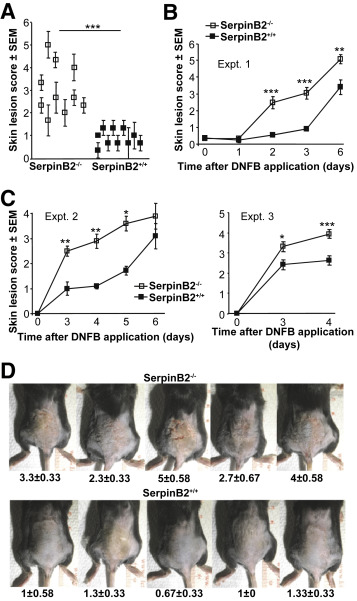SerpinB2 Deficiency Results in a Stratum Corneum Defect and Increased Sensitivity to Topically Applied Inflammatory Agents.
SerpinB2 (plasminogen activator inhibitor type 2) is constitutively expressed at high levels by differentiating keratinocytes in mice and humans; however, the physiological function of keratinocyte SerpinB2 remains unclear. Herein, we show that SerpinB2(-/-) mice are more susceptible to contact dermatitis after topical application of dinitrofluorobenzene, and show enhanced inflammatory lesions after topical applications of phorbol ester. Untreated SerpinB2(-/-) mice showed no overt changes in epithelial structure, and we were unable to find evidence for a role for keratinocyte SerpinB2 in regulating immunity, apoptosis, IL-1β production, proteasomal activity, or wound healing. Instead, the phenotype was associated with impaired skin barrier function and a defective stratum corneum, with SerpinB2(-/-) mice showing increased transepidermal water loss, increased overt loss of stratum corneum in inflammatory lesions, and impaired stratum corneum thickening after phorbol ester treatment. Immunoblotting suggested that SerpinB2 (cross-linked into the cornified envelope) is present in the stratum corneum and retains the ability to form covalent inhibitory complexes with urokinase. Data suggest that the function of keratinocyte SerpinB2 is protection of the stratum corneum from proteolysis via inhibition of urokinase, thereby maintaining the integrity and barrier function of the stratum corneum, particularly during times of skin inflammation. Implications for studies involving genetically modified mice treated with topical agents and human dermatological conditions, such as contact dermatitis, are discussed.
Authors
Wayne A Schroder; Itaru Anraku; Thuy T Le; Thiago D C Hirata; Helder I Nakaya; Lee Major; Jonathan J Ellis; Andreas Suhrbier
External link
Publication Year
Publication Journal
Associeted Project
Microbiology or Immunology
Lista de serviços
-
As antisense RNA gets intronic.As antisense RNA gets intronic.
-
Androgen responsive intronic non-coding RNAs.Androgen responsive intronic non-coding RNAs.
-
Conserved tissue expression signatures of intronic noncoding RNAs transcribed from human and mouse loci.Conserved tissue expression signatures of intronic noncoding RNAs transcribed from human and mouse loci.
-
The intronic long noncoding RNA ANRASSF1 recruits PRC2 to the RASSF1A promoter, reducing the expression of RASSF1A and increasing cell proliferation.The intronic long noncoding RNA ANRASSF1 recruits PRC2 to the RASSF1A promoter, reducing the expression of RASSF1A and increasing cell proliferation.
-
Antisense intronic non-coding RNA levels correlate to the degree of tumor differentiation in prostate cancer.Antisense intronic non-coding RNA levels correlate to the degree of tumor differentiation in prostate cancer.
-
Insight Into the Long Noncoding RNA and mRNA Coexpression Profile in the Human Blood Transcriptome Upon Leishmania infantum Infection.Insight Into the Long Noncoding RNA and mRNA Coexpression Profile in the Human Blood Transcriptome Upon Leishmania infantum Infection.
-
Long non-coding RNAs associated with infection and vaccine-induced immunityLong non-coding RNAs associated with infection and vaccine-induced immunity
-
Comparative transcriptomic analysis of long noncoding RNAs in Leishmania-infected human macrophagesComparative transcriptomic analysis of long noncoding RNAs in Leishmania-infected human macrophages
-
SARS-CoV-2 Selectively Induces the Expression of Unproductive Splicing Isoforms of Interferon, Class I MHC, and Splicing Machinery Genes.SARS-CoV-2 Selectively Induces the Expression of Unproductive Splicing Isoforms of Interferon, Class I MHC, and Splicing Machinery Genes.

